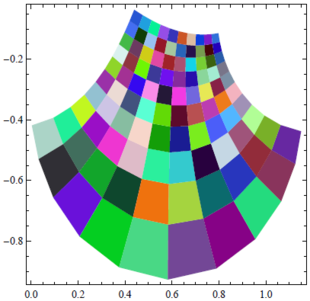12-240/Classnotes for Tuesday September 18: Difference between revisions
No edit summary |
No edit summary |
||
| Line 34: | Line 34: | ||
[Define a^2 = a∙a] |
[Define a^2 = a∙a] |
||
Hint: Use distributive law |
Hint: Use distributive law |
||
'''Thrm 2''': Given a field F, there exists a map Ɩ: Z → F with the properties (∀ m,n ∈ Z): |
'''Thrm 2''': Given a field F, there exists a map Ɩ: Z → F with the properties (∀ m,n ∈ Z): |
||
Revision as of 21:12, 18 September 2012
| |||||||||||||||||||||||||||||||||||||||||||||||||||||||||
Various properties of fields
Thrm 1: In a field F: 1. a+b = c+b ⇒ a=c
2. b≠0, a∙b=c∙b ⇒ a=c
3. 0 is unique.
4. 1 is unique.
5. -a is unique.
6. a^-1 is unique (a≠0)
7. -(-a)=a
8. (a^-1)^-1 =a
9. a∙0=0 **Surprisingly difficult, required distributivity.
10. ∄ 0^-1, aka, ∄ b∈F s.t 0∙b=1
11. (-a)∙(-b)=a∙b
12. a∙b=0 iff a=0 or b=0
. . .
16. (a+b)∙(a-b)= a^2 - b^2 [Define a^2 = a∙a] Hint: Use distributive law
Thrm 2: Given a field F, there exists a map Ɩ: Z → F with the properties (∀ m,n ∈ Z):
1) Ɩ(0) =0, Ɩ(1)=1
2) Ɩ(m+n) = Ɩ(m) +Ɩ(n)
3) Ɩ(mn) = Ɩ(m)∙Ɩ(n)
Furthermore, Ɩ is unique.
Rough proof:
Test somes cases:
Ɩ(2) = Ɩ(1+1) = Ɩ(1) + Ɩ(1) = 1 + 1 ≠ 2
Ɩ(3) = Ɩ(2 +1)= Ɩ(2) + Ɩ(1) = 1+ 1+ 1 ≠ 3
. . .
Ɩ(n) = 1 + ... + 1 (n times)
Ɩ(-3) = ?
Ɩ(-3 + 3) = Ɩ(-3) + Ɩ(3) ⇒ Ɩ(-3) = -Ɩ(3) = -(1+1+1)
What about uniqueness? Simply put, we had not choice in the definition of Ɩ. All followed from the given properties.
At this point, we will be lazy and simply denote Ɩ(3) = 3_f [3 with subscript f]

